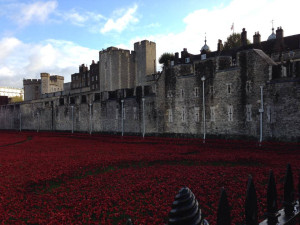The Poppies Flow
Today, the final ceramic poppy was placed in the massive art installation, “Blood Swept Lands and Seas of Red,” at the Tower of London. Designed by artist Paul Cummins, with setting by stage designer Tom Piper, the installation commemorates the great British losses during World War I by representing each British military (including those from then-British colonies) fatality during the war. In the reporting of this art installation/happening, I’ve heard calls for it to remain permanently because it is so moving and beautiful. The poppies were sold to individuals and the money raised will be donated to military-related charities. I’m pleased that this public art installation has raised awareness and money for veterans, and is temporary. Permanency would ruin it.
The “remembrance poppy” has been the symbol of Armistice Day since the 1920s, and has an interesting history of its own. Inspired by the poem, “In Flanders Field,” composed by Canadian field surgeon Lieutenant-Colonel John Alexander McCrae, American Moina Belle Michael designed an artificial flower and convinced the American Legion to adopt it as its symbol.
The poppy is a wonderful symbolic flower that has some staying power. Poppies grow on many continents and they embody contradictions–it’s a tough flower but delicate and beautiful; it transforms into nourishment and into a narcotic. It has been used by many different cultures to remember the dead.
As a symbol of the war dead, its power is not in its ubiquity but in the ways that it is worn and displayed near or on Armistice/Veterans’ Day. The poppies are put away, or discarded, until the following year. Poppies are not worn on every lapel every day of the year.
Robert Musil argued in his famous essay on monuments in 1927 that “there is nothing in the world so invisible as a monument.” While this is not always the case, we must remember that the meaning of public monuments change over time through a process of social and cultural meaning making.
This is why the installation at the Tower of London is so powerful: it’s temporary. The power rests in the emotions and experiences felt now. This impact will not persist. It is for these reasons that historians of monuments and memorialization, such as Kirk Savage, argue temporary memorials offer better ways of remembering significant events in public spaces like the National Mall, rather than continuing to build large, expensive, permanent memorials.
Re-visioning and reinterpreting existing environments and structures motivate artists like Christo and Jeanne-Claude. “Blood Swept Lands and Seas of Red” is a type of “wrapping,” even if not created with the same purpose as the Wrapped Reichstag. While the primary purpose of Cummins work is to remember the losses of World War I, the poppies could serve another cultural function by encouraging visitors to see the Tower of London and its history–not only of holding the Crown Jewels, but of torture and death–in new ways.
I really like Cummins piece, because its simplicity is incredibly complicated. The flow of red emerging from the Tower that spills into the moat speaks of those lost bodies in wars past and present. These ceramic poppies do not flow like water would, and so are silent in a way that makes me also see that this memorial can represent those fighting silent killers, carried in the blood stream…the cancers, the infectious diseases.
Enjoy this installation for the cultural work it is performing now. The bright red poppies demand our attention, and ask us to reflect on the meaning and consequences of war. I am moved to ask, will this flow ever end?
In Flanders fields the poppies blow
Between the crosses, row on row,
That mark our place; and in the sky
The larks, still bravely singing, fly
Scarce heard amid the guns below.
We are the Dead. Short days ago
We lived, felt dawn, saw sunset glow,
Loved and were loved, and now we lie
In Flanders fields.
Take up our quarrel with the foe:
To you from failing hands we throw
The torch; be yours to hold it high.
If ye break faith with us who die
We shall not sleep, though poppies grow
In Flanders fields.
— John McCrae, 1915
